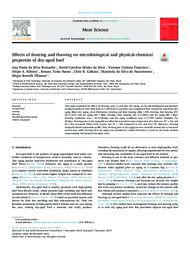Effects of freezing and thawing on microbiological and physical-chemical properties of dry-aged beef.
Effects of freezing and thawing on microbiological and physical-chemical properties of dry-aged beef.
Author(s): BERNARDO, A. P. da S.; SILVA, A. C. M. da; FRANCISCO, V. C.; RIBEIRO, F. A.; NASSU, R. T.; CALKINS, C. R.; NASCIMENTO, M. da S.; PFLANZER, S. B.
Summary: This study evaluated the effects of freezing, prior to and after dry aging, on the microbiological and physical-chemical quality of beef. Strip loins (n = 24) from 12 carcasses were assigned to four treatments: non-frozen dry aging (Dry); dry aging, steak fabrication, freezing and slow thawing (Dry + ST); freezing, fast thawing (FT; 20 °C/15 h) and dry aging (FT + Dry); freezing, slow thawing (ST; 4°C / 48h) and dry aging (ST + Dry). Freezing conditions were - 20°C/28 days and dry aging conditions were 2°C/70% relative humidity, for 28 days. Freezing prior to dry aging did not affect the microbial counts compared to Dry. However, FT + Dry and ST + Dry increased (16%) total process loss (P < .05) compared to Dry and Dry+ST. Moreover, freezing changed volatile compounds profile. Thus, freezing prior to dry aging was not a feasible process due to increased process loss, while freezing after dry aging was considered a viable alternative to preserve the steaks without compromising beef physical-chemical traits.
Publication year: 2020
Types of publication: Journal article
Observation
Some of Embrapa's publications are published as ePub files. To read them, use or download one of the following free software options to your computer or mobile device. Android: Google Play Books; IOS: iBooks; Windows and Linux: Calibre.
Access other publications
Access the Agricultural Research Database (BDPA) to consult Embrapa's full library collection and records.
Visit Embrapa Bookstore to purchase books and other publications sold by Embrapa.

